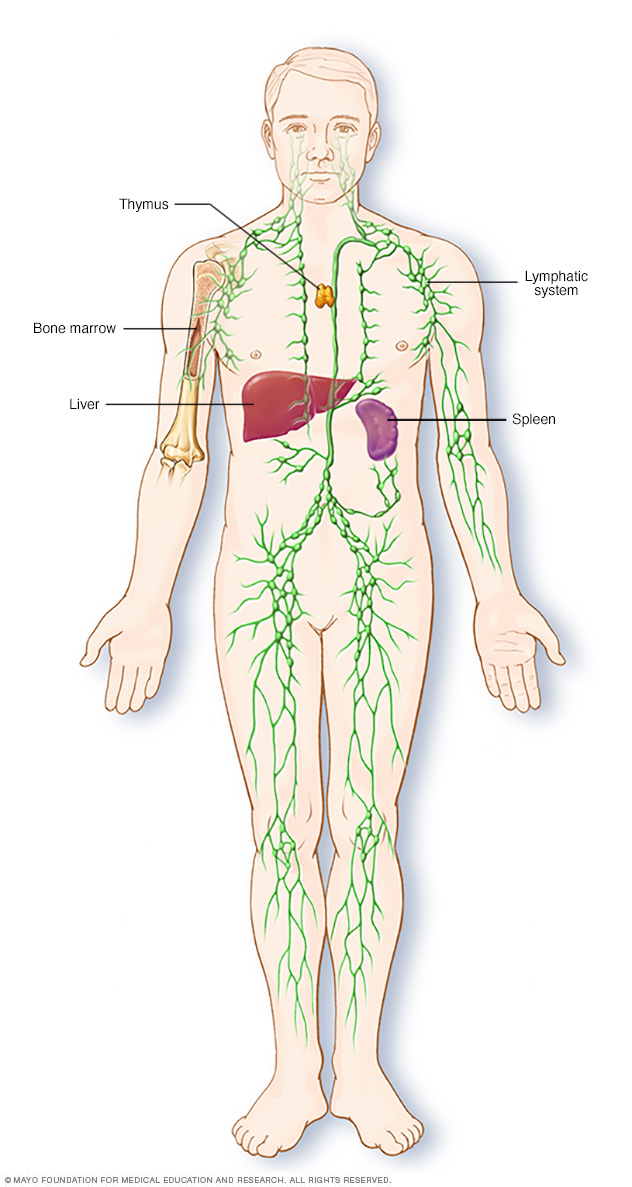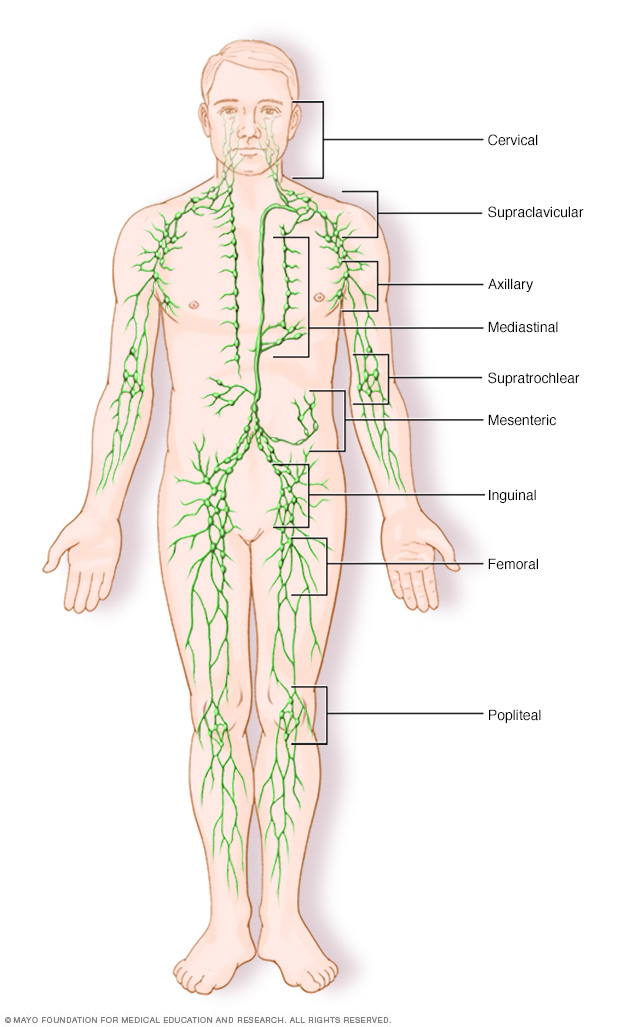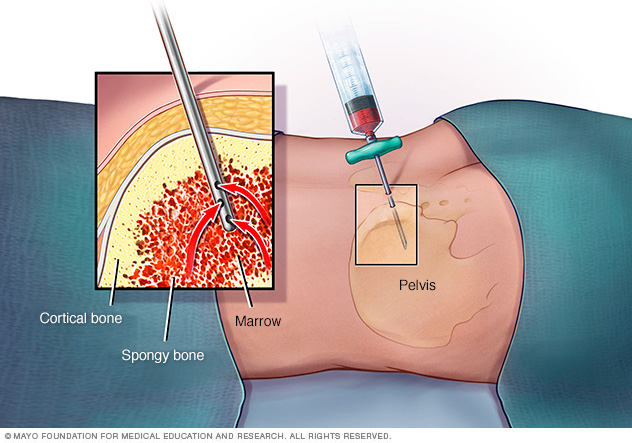Overview
Non-Hodgkin lymphoma is a type of cancer that affects the lymphatic system. The lymphatic system is made up of organs, glands, tubelike vessels and clusters of cells called lymph nodes. It's part of the body's germ-fighting immune system.
Non-Hodgkin lymphoma happens when germ-fighting cells in the lymphatic system grow out of control. The cells can form growths, called tumors, throughout the body.
Non-Hodgkin lymphoma is a broad group of lymphomas. There are many subtypes in this group. Diffuse large B-cell lymphoma and follicular lymphoma are among the most common subtypes. The other broad group of lymphoma is Hodgkin lymphoma.
Advances in diagnosis and treatment of non-Hodgkin lymphoma have helped improve the prognosis for people with this condition.

Symptoms
Signs and symptoms of non-Hodgkin lymphoma may include:
- Swollen lymph nodes in the neck, armpits or groin.
- Belly pain or swelling.
- Chest pain, coughing or trouble breathing.
- Feeling very tired.
- Fever.
- Night sweats.
- Weight loss without trying.
When to see a doctor
Make an appointment with your doctor if you have any persistent signs and symptoms that worry you.
Causes
The cause of non-Hodgkin lymphoma often isn't known. This cancer starts when germ-fighting white blood cells called lymphocytes develop changes in their DNA. A cell's DNA holds the instructions that tell the cell what to do.
DNA gives healthy cells instructions to grow and multiply at a set rate. The instructions tell the cells to die at a set time. In cancer cells, the DNA changes give other instructions. The DNA changes tell the cancer cells to make more cells quickly. Cancer cells can keep living when healthy cells would die. This causes too many cells.
In non-Hodgkin lymphoma, the cancer cells often build up in the lymph nodes. They also can build up in other parts of the lymphatic system.
Non-Hodgkin lymphoma can affect the:
- Lymph nodes.
- Lymph vessels.
- Adenoids.
- Tonsils.
- Spleen.
- Thymus.
- Bone marrow.
- Rarely, parts of the body that aren't part of the lymphatic system.
Non-Hodgkin lymphoma types
Non-Hodgkin lymphoma most often begins in the:
- B cells. B cells are a type of lymphocyte that fights infection. B cells make antibodies against foreign invaders. Most non-Hodgkin lymphoma arises from B cells. Subtypes of non-Hodgkin lymphoma that involve B cells include diffuse large B-cell lymphoma, follicular lymphoma, mantle cell lymphoma and Burkitt's lymphoma.
- T cells. T cells are a type of lymphocyte that kills foreign invaders directly. Non-Hodgkin lymphoma happens much less often in T cells. Subtypes of non-Hodgkin lymphoma that involve T cells include peripheral T-cell lymphoma and cutaneous T-cell lymphoma.
Treatment depends on whether non-Hodgkin lymphoma arises from B cells or T cells.

Risk factors
Factors that may raise the risk of non-Hodgkin lymphoma include:
- Medicines that lower the immune response. Taking medicines that manage the immune system after an organ transplant might raise the risk of non-Hodgkin lymphoma.
- Infection with certain viruses and bacteria. Certain infections seem to raise the risk of non-Hodgkin lymphoma. Viruses linked to this type of cancer include HIV and Epstein-Barr virus. Bacteria linked to non-Hodgkin lymphoma include the stomach ulcer-causing bacterium Helicobacter pylori.
- Chemicals. Certain chemicals, such as those used to kill insects and weeds, may raise the risk of non-Hodgkin lymphoma. More research is needed to find the possible link between pesticides and non-Hodgkin lymphoma.
- Older age. Non-Hodgkin lymphoma can happen at any age. But it's most common in people 60 or older.
There's no way to prevent non-Hodgkin lymphoma.
Diagnosis
Non-Hodgkin lymphoma diagnosis often begins with an exam that checks for swollen lymph nodes in the neck, underarms and groin. Tests include imaging tests and removing some cells for testing. The tests used to detect non-Hodgkin lymphoma may depend on the cancer's location and your symptoms.
Physical exam
A healthcare professional checks for swollen lymph nodes in your neck, underarms and groin. The health professional also checks for a swollen spleen or liver.
Blood and urine tests
Tests of your blood and urine may help rule out an infection or other disease.
Imaging tests
Tests to look for lymphoma cells in other parts of the body may include CT, MRI and positron emission tomography, also called PET.
Lymph node biopsy
Your healthcare professional may suggest a lymph node biopsy to look for cancer cells. A biopsy is a procedure to remove a sample of tissue for testing in a lab. A lymph node biopsy involves removing all or part of a lymph node. In the lab, tests may show whether you have non-Hodgkin lymphoma and, if so, which type.
Bone marrow tests
Bone marrow aspiration and biopsy are procedures that involve collecting cells from the bone marrow. The cells are sent for testing.
In a bone marrow aspiration, a needle is used to draw a sample of the fluid. In a bone marrow biopsy, a needle is used to collect a small amount of the solid tissue. The samples most often come from the hip bone.
Lumbar puncture
A lumbar puncture involves removing some of the fluid around the spinal cord. This procedure also is called a spinal tap. A healthcare professional might recommend this test if there's concern that the lymphoma affects the fluid around the spinal cord. A lumbar puncture involves putting a small needle into the spinal canal in the lower back to withdraw the fluid.

Treatment
Non-Hodgkin lymphoma treatment often starts with medicines or radiation therapy. Medicines used for this cancer include chemotherapy, immunotherapy and targeted therapy.
The treatments your healthcare team chooses for you depend on your lymphoma. Your healthcare team considers the types of cells involved and how quickly the cancer is growing. Your team also considers your overall health and what you prefer.
If your lymphoma seems to be growing slowly and doesn't cause symptoms, you might not need treatment right away. Instead, you may have checkups every few months. The checkups help your healthcare team watch your condition and see if your cancer is growing.
Chemotherapy
Chemotherapy treats cancer with strong medicines. There are many chemotherapy medicines. Most chemotherapy medicines are given through a vein. Some come in pill form.
For many types of non-Hodgkin lymphoma, chemotherapy is the first treatment. Sometimes it's combined with targeted therapy.
Immunotherapy
Immunotherapy for cancer is a treatment with medicine that helps the body's immune system kill cancer cells. The immune system fights off diseases by attacking germs and other cells that shouldn't be in the body. Cancer cells survive by hiding from the immune system. Immunotherapy helps the immune system cells find and kill the cancer cells.
People with certain types of non-Hodgkin lymphoma may have immunotherapy if other treatments haven't helped.
Targeted therapy
Targeted therapy for cancer is a treatment that uses medicines that attack specific chemicals in the cancer cells. By blocking these chemicals, targeted treatments can cause cancer cells to die.
For non-Hodgkin lymphoma, targeted therapy may be used alone. But more often, it's combined with chemotherapy. This mix may be your first treatment. It can be your second treatment if your lymphoma comes back.
CAR-T cell therapy
Chimeric antigen receptor T cell therapy, also called CAR-T cell therapy, trains the immune system cells to fight non-Hodgkin lymphoma. This treatment begins with removing some white blood cells, including T cells, from the blood.
The cells are sent to a lab. In the lab, the cells are treated so that they make special receptors. The receptors help the cells recognize a marker on the surface of the lymphoma cells. Then the cells go back into the body. There they find and destroy the non-Hodgkin lymphoma cells.
CAR-T cell therapy might be an option for certain types of B-cell non-Hodgkin lymphoma. It's typically used when other treatments haven't worked.
Bone marrow transplant
A bone marrow transplant, also called a bone marrow stem cell transplant, involves putting healthy bone marrow stem cells into the body. These cells replace cells hurt by chemotherapy and other treatments. People with non-Hodgkin lymphoma may have a bone marrow transplant if other treatments haven't helped.
Radiation therapy
Radiation therapy treats cancer with powerful energy beams. The energy can come from X-rays, protons or other sources. During radiation therapy, you lie on a table while a machine moves around you. The machine directs radiation to precise points on your body.
For certain types of non-Hodgkin lymphoma, radiation therapy may be the only treatment you need. This may be true if your lymphoma is in just one or two spots and grows slowly.
People with non-Hodgkin lymphoma also may need radiation after chemotherapy to kill any lymphoma cells that might remain. Radiation also can relieve symptoms and improve quality of life.
Alternative medicine
No alternative medicines have been found to cure non-Hodgkin lymphoma. But alternative medicine may help you cope with a cancer diagnosis and the side effects of cancer treatment. Talk with your healthcare team about your choices, such as:
- Art therapy.
- Exercise.
- Meditation.
- Music therapy.
- Relaxation exercises.
- Spirituality.
Coping and support
A non-Hodgkin lymphoma diagnosis can be a challenge. The following ideas and resources may help you deal with cancer:
Learn about non-Hodgkin lymphoma
Learn enough about your cancer to feel OK about making decisions about your treatment and care. Talk with your healthcare team. Look for information in your local library and on the internet. The U.S. National Cancer Institute and the Leukemia & Lymphoma Society are two good sources.
Keep a strong support system
Keep relationships strong to help you deal with your non-Hodgkin lymphoma. Friends and family can give you the support you may need, such as helping take care of your home if you're in the hospital. And they can give you emotional support.
It also may help to join a support group or talk with others who have cancer.
Set goals you can reach
Set goals to help you feel in control and give you a sense of purpose. But don't set goals you aren't likely to reach. For instance, you may not be able to work a 40-hour week. But you may be able to work part time.
Take time for yourself
Eat well, relax and get enough rest to help with the stress and tiredness of cancer. Also, plan for times when you may need to rest more or limit what you do.
Stay active
Getting a cancer diagnosis doesn't mean you have to stop doing the things you enjoy. For the most part, if you feel well enough to do something, do it. It's important to stay active and involved as much as you can.
Preparing for an appointment
Make an appointment with a healthcare professional if you have any symptoms that worry you. Your healthcare professional may send you to a doctor who specializes in diseases that affect blood cells, called a hematologist.
Here's some information to help you get ready for your appointment.
What you can do
- Ask about what you need to do before your appointment. When you make the appointment, ask if there's anything you need to do in advance, such as restrict your diet before testing.
- Write down your symptoms, including any that don't seem linked to the reason you made the appointment, and when they began.
- Write down key personal information, including any major stresses or recent life changes.
- Make a list of all medicines, vitamins or supplements you take, including dosages.
- Ask a family member or friend to come along to help you remember the information you get.
- Write down questions to ask your healthcare professional.
For non-Hodgkin lymphoma, some questions to ask include:
- Do I have non-Hodgkin lymphoma?
- What type of non-Hodgkin lymphoma do I have?
- How advanced is my cancer?
- Is my condition growing quickly or slowly?
- Will I need more tests?
- Will I need treatment?
- What are my treatment choices?
- What are the potential side effects of each treatment?
- How will treatment affect my daily life? Can I keep working?
- Should I see a specialist?
- Do you have brochures or other printed material that I can have? What websites do you suggest?
Be sure to ask all the questions you have.
What to expect from your doctor
Your healthcare professional may ask you questions, such as:
- Do you have symptoms all the time or do they come and go?
- How bad are your symptoms?
- What, if anything, seems to make your symptoms better?
- What, if anything, seems to make your symptoms worse?
- Have you had infections in the past?
- Have you or your family been exposed to poisons?
© 1998-2025 Mayo Foundation for Medical Education and Research (MFMER). All rights reserved. Terms of Use


